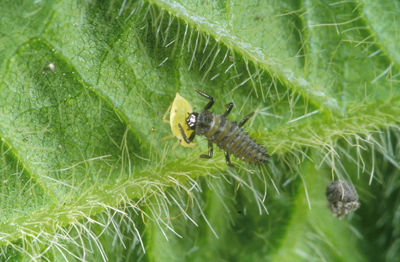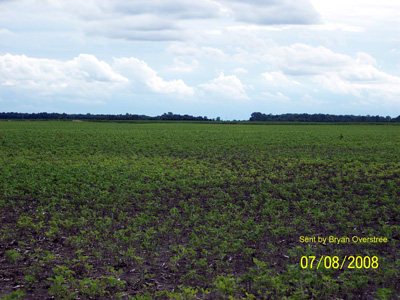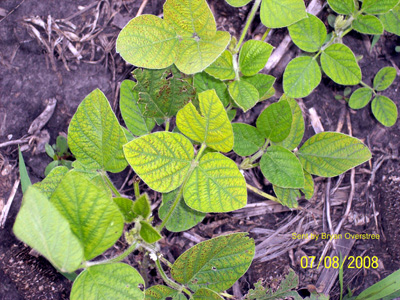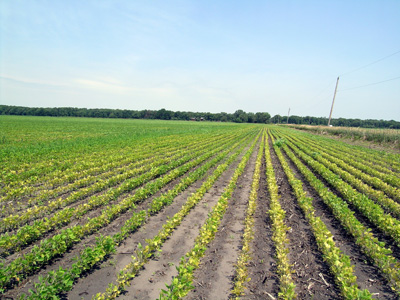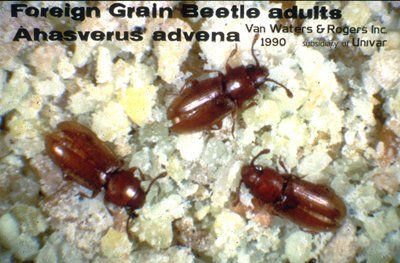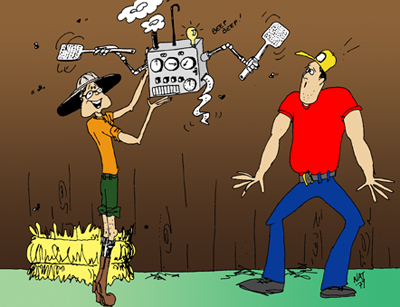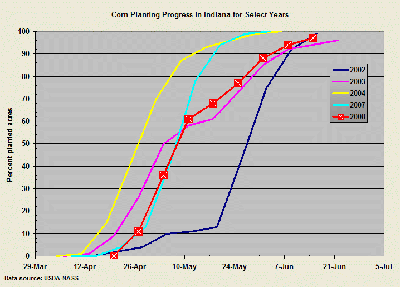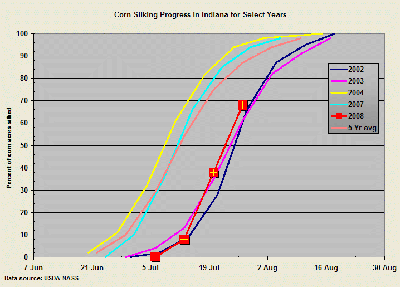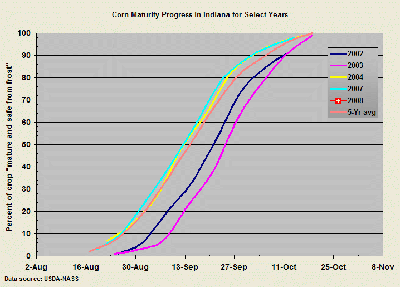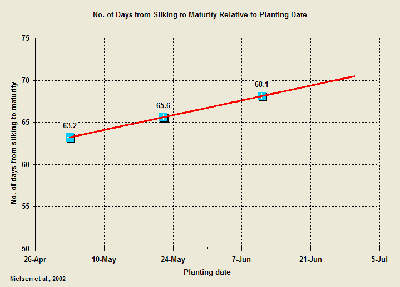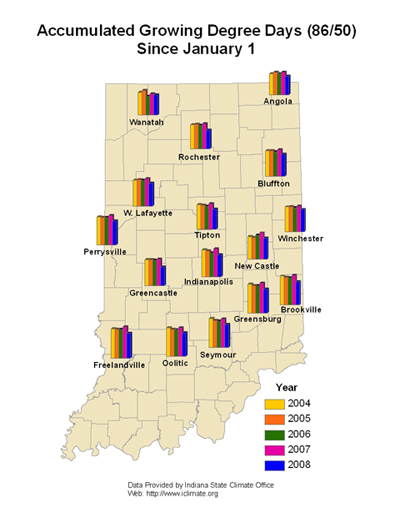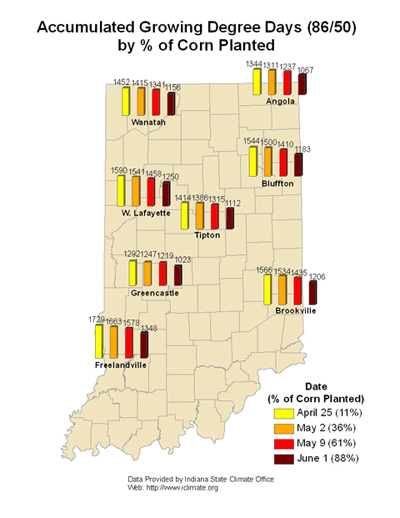Pest & Crop Newsletter, Entomology Extension, Purdue University
- Soybean Insecticides: Truth or Consequences
- Nematode Updates 2008: Soybean Cyst Nematode
- Watch Out for Mold Feeding Insects
- Black Light Trap Catch Reports
Soybean Insecticides: Truth or Consequences – (John Obermeyer and Larry Bledsoe)
- Japanese beetle numbers have been low this year, populations are now further declining
- 10-15+% defoliation in R3 soybean is needed before insecticides are justified.
- Fungicides control both plant and insect pathogens.
- Dry weather + fungicide + insecticide = mite/aphid outbreak.
- Honeybees will be killed with insecticide applications.
Fungicide applications to corn has been ongoing for some time and it seems soybean fields are now in the queue. It seems that scouting to determine the need for a fungicide in the crop beforehand is lacking, as fields were “booked” for application months ago. Word on the street is that insecticides are being tank mixed with fungicides for the insects that might be there. Perhaps a Japanese beetle was seen flying by or there are memories of past aphid infestations.
Truth: Japanese beetle is Indiana’s primary soybean defoliator. Its showy color, propensity to feed on top of the canopy, and movement in mass during the heat of the day makes itself easily noticed, especially while one drives by the field and hears the pelting of the windshield. Japanese beetle emits two pheromones, one is a feeding aggregate, the other, and often joked about…for mating. In other words, they clump together on plants, further attributing to overestimating their overall numbers and damage.
Japanese beetle numbers have peaked throughout the state. That means beetle numbers are on the decline, although some beetles will remain until late in the season. This too means that peak feeding/defoliation throughout the state has occurred. They can, and often will, move to “greener pastures,” such as late-planted soybean for more palatable foliage. Another reason that scouting each field is important.

This showy display of beetles and damage will exaggerate defoliation estimates
Japanese beetle can defoliate enough foliage to justify treating, especially with current commodity prices. Soybean is most vulnerable to damage during the beginning pod stage (R3). If beetles are still actively feeding, defoliation of approximately 10-15%, at the R3 growth stage, is economically justified to treat. Estimating defoliation is truly an art, as one must visualize leaf removal not only on plants but the field as a whole. Concentrating attention to top-foliage damage where beetles are grouped will greatly exaggerate defoliation estimates.
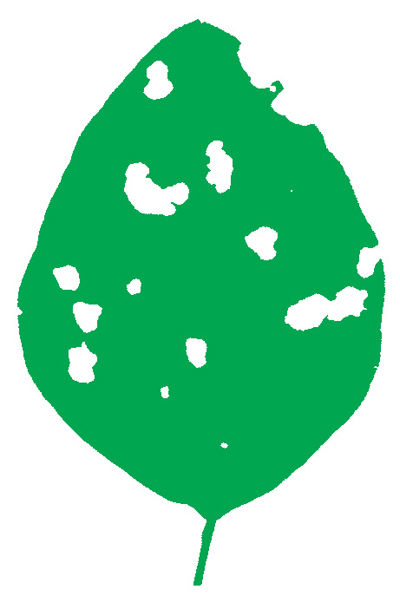
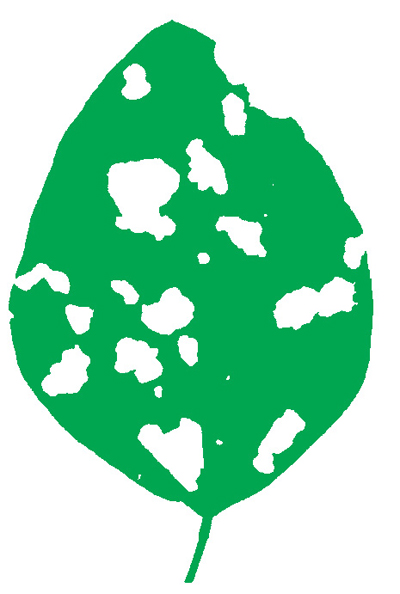
To economically justify treating soybean at R3 growth,
defoliation throughout the plant and field must be
comparable to this 10% (left) and 20% (right) defoliation represented on these leaflets
Concerning soybean aphid, numbers are extremely low throughout the state. We are not aware of one field that has approached anything close to the 250 aphids/plant threshold. By the way, this threshold is applicable for today’s soybean prices. Soybean aphids at less than 250/plant do NOT reduce yield.
Consequences: There are concerns associated with adding an insecticide to the spray mix just to “clean up” any insects that may be present.
Lurking in every soybean field, all season long, are low numbers of various species of spider mites and aphids. We rarely notice these pests when conditions remain “normal” due to the actions their natural enemies. However, treating fields with an insecticide may tip the balance in the favor of potential pests. This is because natural enemies recover more slowly from broad-spectrum insecticides compared with mites and aphids, which have an extremely rapid generation time.
Dry conditions, present in several areas of the state, exacerbate crop damage from mites and aphids. One major reason for this is because pathogens, that cause insect diseases, do not flourish in dry environments. Just as crop diseases are more likely during wet/high humid conditions, so are insect diseases. An epizootic is quite impressive, as potentially damaging populations of mites/aphids are quickly and thoroughly wiped out. Fungicides sprayed for crop diseases also control these beneficial pathogens. This is one reason why high-value crops, e.g., fruits and vegetables, receiving prophylactic (calendar sprays) of fungicide and insecticide often have spider mite flare-ups.
Preserve the natural enemies, give this lady beetle larva a chance
Ron Hammond, Ohio State University field crops entomologist, adds another point to this consequences list. Pollinators, specifically bees, are present in soybean fields. Though soybean are self-pollinating and aren’t reliant on these beneficial insects, bees will often visit fields. Pyrethroid insecticides, needless to say, are deadly to bees and a multitude of other pollinators. With the recent woes, e.g., mites, colony collapse, etc. of the honeybee, further reduction in populations in only adds to the injury.
Lastly, it must be emphasized that insecticides do NOT increase yield, they only preserve it. Any yield enhancing claims with insecticides are not only misleading but against the law. This one fact alone should make producers wary and monitor fields before treatments are made.
Happy scouting and be informed!
![]()
Nematode Updates 2008: Soybean Cyst Nematode - (Jamal Faghihi and Virginia Ferris)
Indiana Soybean Alliance is supporting an ongoing SCN survey in 2008-2009. As part of this survey we are conducting random sampling from soybean fields throughout Indiana. We hope to gain a better understanding of the distribution and behavior of SCN in Indiana. As part of this survey, we sampled several soybean fields in Northwest Indiana on 7/2/2008. We observed an alarming number of fields showing typical SCN symptoms, often associated with manganese deficiencies. The SCN symptoms are usually in patches of yellow and stunted soybeans. The yellow or white new cysts should be visible on the soybean roots. To see these cysts, dig the soybean plants out of the ground with a shovel and dip in a bucket of water to observe the new cysts. Care must be taken when digging the plants as the cysts are loosely attached to the soybean roots. Bryan Overstreet, the extension educator in Jasper County, sent several pictures of infested roots from soybean plants that are supposedly SCN resistant. He also mentioned that growers have to spray manganese more often in recent years. As we pointed out last year, the field populations of SCN in Indiana might be changing in ways that render the most common source of resistance to SCN (PI 88788) less effective. Other researchers in the region have reported similar trends. The symptoms that we are observing might be related to SCN overcoming the PI 88788 resistance.
With funding from the North Central Soybean Research Program we have nearly completed a large survey among three States and a Canadian province. These locations were chosen based on the number of years that varieties with PI 88788 have been grown. The indications are that there might be correlations between numbers of SCN populations that can overcome PI 88788 resistance and the length of time these resistant varieties have been used. Our research and that of others has shown that SCN populations are adapting to the PI 88788 source of resistance. However, varieties with this source of resistance still play a major role in management of SCN but new sources of resistance must be incorporated in SCN resistant cultivars as soon as possible. SCN continues to remain an elusive pest that requires constant monitoring and testing.
Why is further SCN soil testing needed when it is already known to be present? Soil tests are the only accurate way to know whether the numbers of SCN are changing and whether a resistant variety is still working. Growers need to understand that genetic shifts in SCN populations are gradual and they should not wait for yield losses before determining that a change in the SCN population has occurred. About two months after planting, where SCN presence has been previously confirmed, inspect for the tiny white and yellow SCN females on the roots (you should be able to see these new cysts on the soybean roots now). Or send soil plus root samples in the middle of the growing season to a nematology laboratory to determine the effectiveness of the resistant variety growing in the field. If race determination has been performed for a field population in the past, you might want to repeat the test after about four soybean crops to measure any possible changes. If no race profile exists for a field, one needs to be established so future comparisons are possible. In other words, planting SCN resistant varieties is not the final solution to the SCN problem. The management of this pest is an ongoing and dynamic one that requires constant vigilance.
The best way to manage SCN over the years is to monitor your populations by sampling each field at least every four years. You can sample the soil anytime of the year and get an accurate understanding of the cyst population. This is a very crucial step in SCN management and should not be neglected. We provide this service to soybean growers at the cost of $10/sample, for which the submitter will receive a bill unless we are instructed otherwise. For more information on other services that we provide you may visit our Nematology website: <http://www.entm.purdue.edu/nematology/>.
If you have any questions about SCN or any other kinds of plant parasitic nematodes, you can contact Jamal Faghihi at 765-494-5901 or send an email to jamal@purdue.edu. Soil samples for nematode analysis can be sent to: Nematology laboratory, Purdue University, Department of Entomology, Smith Hall, 901 W. State Street, West Lafayette, IN 47907-2089.
![]()
Watch Out for Mold Feeding Insects! - (Linda J. Mason)
Hopefully flood-damaged grain has been dried or disposed of by now. However, the risk for storage insects, especially mold feeding insects remains high for the remainder of the storage season. Molds spores are a favorite food for mold feeding insects such as the hairy fungus beetles and foreign grain beetles. The combination of warm temperatures and numerous mold sources has resulted in a steady increase in these storage pests. Although these insects do not directly damage homes, grain or bite people, they will become a nuisance pest in and around flooded structures and nearby grain storage facilities.
Mold feeding insects thrive in warm moist organic matter, and some mold feeders, like the hairy fungus beetle, especially like mold species that produce aflatoxin. For example, aflatoxin production by A. flavus occurs when equilibrium MC exceeds 85% and grain temperatures range from 54° to 104°F. Both conditions will exist around previous flooded residential and business structures (especially grain elevators).
Under normal storage conditions, fungus feeding beetles may be found indoors or outdoors in places where grains or other food products are stored under conditions favorable for mold to grow. Flood-damaged grain is even better, and even when dried, mold spores and aflatoxins will persist. The presence of mold feeding insects is an excellent indicator that grains may have been flood-damaged and/or are going out of condition. For the remainder of this storage season, be on the lookout for mold feeding pests in grain samples.
Foreign grain beetle
Hairy fungus beetle
![]()
They told me it would keep away those mold feeding insects!
Late Planted Corn: Enough Time to Mature? - (Bob Nielsen)
As Indiana’s corn crop enters the final stretch of the season, folks with late-planted corn are looking ahead on the calendar and wondering whether their fields will mature safely before the arrival of a killing fall freeze. Technically, 97% of Indiana’s corn crop was planted as of June 15 (Fig. 1, USDA-NASS, 2008), but more than the usual number of acres were replanted later than that as a result of poor stand survival due to the June floods and field ponding events.
Fig. 1. Corn planting progress in Indiana for 2008 in comparison with select other years. Data source: USDA-NASS.
The developmental consequences of the late finish to corn planting, the lateness of many replanted fields, and the relatively cool start to the growing season are reflected in the delayed silking progress of the state’s corn crop to date (Fig. 2, USDA-NASS, 2008). As of 27 July, Indiana’s corn silking progress is 1.5 to 2 weeks behind the most recent 5-year average and closely resembles the progress of the 2002 and 2003 crops.
Fig. 2. Corn silking progress in Indiana as of July 27, 2008 in comparison with select other years. Data source: USDA-NASS.
If the comparison to those years holds through to maturity, quite a bit of Indiana’s corn crop may mature from late September through mid-October (Fig. 3). That prospect is the reason why folks are looking to the calendar and praying that the first killing fall freeze does not come early this year.
Fig. 3. Corn maturity progress in Indiana for select years. Data source: USDA-NASS.
Most agronomists consider 28°F as the definition of a killing fall freeze for corn. Frosts that occur at higher temperatures may damage leaves, but typically do not kill the whole plant. Climatologists work with years of weather data and develop probability tables that offer some guidance on when to expect such damaging killing fall freezes.
Based on such climatological historical normals for Indiana (National Climatic Data Center, 2008), a killing fall freeze occurs 10% of the time, on average, by the 10th of October in Indiana and ranges from as early as the first week of October to the last week of October depending on the area of the state. Fifty percent of the time, on average, a killing frost freeze occurs by the 26th of October in Indiana and ranges from as early as mid-October to as late as mid-November.
Given that perspective on fall freeze dates, what can be said about the likelihood that a given field of corn will mature safely (physiological maturity, kernel black layer) prior to a killing freeze? One of the simplest means by which to estimate maturity date may be in terms of number of days after silking.
Results from earlier research on corn development with delayed planting (Nielsen et al., 2002) suggest that corn planted in mid- to late-June in Indiana and Ohio will typically mature from 68 to 71 days after silking (Fig. 4). The number of days from silking to maturity increases with later-planted corn primarily because growing degree day (GDD) accumulation per day decreases dramatically toward late summer and early fall (Fig. 5) and so it simply requires more calendar days for a late-silking crop to accumulate a minimum number of GDDs to reach physiological maturity.
Fig. 4. Number of days from silking to physiological maturity for three corn hybrids and 12 environments in Indiana and Ohio, 1991-1994. Data adapted from Nielsen et al., 2002.
Fig. 5. Change in daily growing degree day (GDD) accumulation throughout a growing season. Data collected in 2007 at the Purdue Crop Diagnostic Training & Research Center, near W. Lafayette, IN.
These results do not bode well for late-planted corn that silks during the first or second week of August, because they suggest that physiological maturity of such late-silking corn may not occur until mid- to late-October where the risks of a killing fall freeze increase. Furthermore, grain of late-maturing crops will not dry as quickly in the field prior to harvest because of the naturally cooler temperatures of that time of the year (Nielsen, 2008).
Related References
National Climatic Data Center. 2008. Frost/Freeze Data for Indiana, 1971-2000. U.S. Dept Commerce - National Climatic Data Center. [On-line]. Available at <http://cdo.ncdc.noaa.gov/climatenormals/clim20supp1/states/IN.pdf>. [URL accessed 7/29/08].
Nielsen, R.L. (Bob). 2007. Grain Fill Stages in Corn. Corny News Network, Purdue Univ. [On-line]. Available at <http://www.kingcorn.org/news/timeless/GrainFill.html>. [URL accessed 7/29/08].
Nielsen, R.L. (Bob). 2008. Field Drydown of Mature Corn Grain. Corny News Network, Purdue Univ. [On-line]. Available at <http://www.kingcorn.org/news/timeless/GrainDrying.html>. [URL accessed 7/29/08].
Nielsen, R.L., P.R. Thomison, G.A. Brown, A.L. Halter, J. Wells, & K.L. Wuethrich. 2002. Delayed Planting Effects on Flowering and Grain Maturation of Dent Corn. Agron. J. 94:549-558.
USDA-NASS. 2008. Weekly Crop & Weather Reports. Indiana Office of USDA-NASS. [On-line]. Available at <http://www.nass.usda.gov/Statistics_by_State/Indiana/Publications/Crop_
Progress_&_Condition/index.asp>. [URL accessed 7/29/08].
![]()

